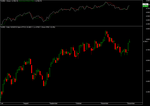Stock Portfolio Organizer
The ultimate porfolio management solution.
WiseTrader Toolbox
#1 Selling Amibroker Plugin featuring:
Distance Coefficient Ehlers Filter for Amibroker (AFL)
Rocket Science for Traders: Digital Signal Processing Applications.
The Distance Coefficent Ehlers Filter is a type of filter in the non-linear FIR (Finite Impulse Response) filter class. This type of filter is great for filtering out pricing data that isn’t stationary. ie, cycling.
It can be used similarly to the SMA (Simple Moving Average) or the EMA (Exponential Moving Average). There is more to it than that, but the details are better understood by reading his book. I’ve found the Distance Coefficient Ehlers Filter to be much more responsive than either the Simple Moving Average, or the Exponential Moving Average, but it also has to do with the stationary vs non-stationary response that the stock is undergoing.
Screenshots
Similar Indicators / Formulas
Indicator / Formula
_SECTION_BEGIN("EhlersDistCoefFilter");
//EhlersDistCoefFilter
//Taken from the article in TASC's April 2001 Issue.
Price = (H+L)/2;
CoefLookback = 5;
Coef = (Price-Ref(Price, -1))^2+(Price-Ref(Price, -2))^2+(Price-Ref(Price, -3))^2+(Price-Ref(Price, -4))^2+(Price-Ref(Price, -5))^2;
SumCoef=0;
SumCoefPrice=0;
for(i=0; i < CoefLookback; i++) {
SumCoef = SumCoef + Ref(Coef, -i);
SumCoefPrice = SumCoefPrice + (Ref(Coef, -i) * Ref(Price, -i));
}
DCEF = SumCoefPrice / SumCoef;
Plot(Close, "Close", colorWhite, styleLine);
Plot(DCEF, "NonLinear Ehlers Filter", IIf(Close>DCEF, colorGreen, colorRed), styleLine);
_SECTION_END();2 comments
Leave Comment
Please login here to leave a comment.
Back
Good and well explained:thanks.
Good and well explained:thanks.